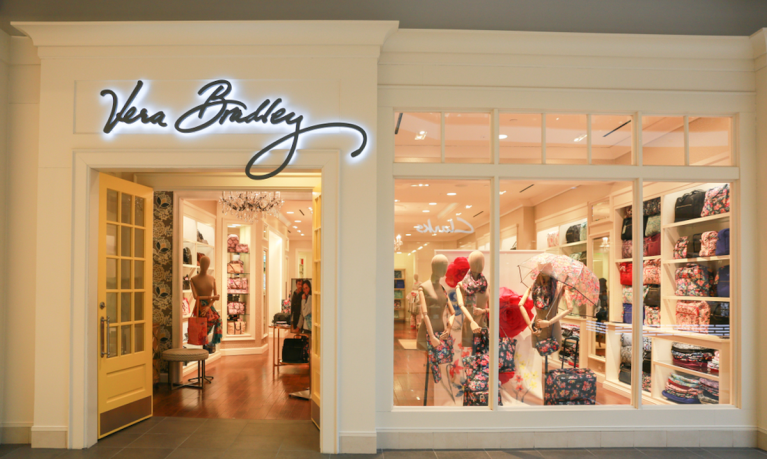As Vera Bradley transforms to meet consumers’ evolving omnichannel expectations, the brand is upgrading its stores to better fit how consumers want to shop.
In an interview with PYMNTS following the accessories, fashion and home goods brand’s announcement of its refresh, CEO Jackie Ardrey shared how the company is upgrading the brick-and-mortar experience.
“It’s just amazing when, when you talk to store managers and associates, how excited they are, because they report feeling like, ‘I just got a new house. I feel like I’m walking into something new and refreshing every day,’” Ardrey said.
The brand streamlined its product offerings to eliminate the previously overwhelming clutter, making stores more spacious and easier to navigate, following feedback from customers and non-customers alike that stores were “overwhelming and very hard to shop.” The brand has added new storage fixtures on the floor for easier product retrieval.
Personalized and Interactive
Additionally, new fixtures highlighting customizable options, such as various wallet styles, colors and fabrics, as well as add-on accessories, caters to the growing demand for personalization.
“People want to have their own individual style. … A lot of [our customers’] feedback is that that’s why they buy Vera,” Ardrey said. “We don’t want to tell them what their style is. We want them to have that journey and vehicle for self-expression.”
Advertisement: Scroll to Continue
The stores also feature new signage and interactive flip charts to provide detailed communications about products, making the shopping experience more engaging and informative. Ardrey noted that these interactive elements help engage the types of customers who may prefer self-guided shopping journeys to speaking with associates.
“When we provide them the tools in store to do that, we see that they use them,” she said.
The in-store experience is key to consumers’ connection with brands. The PYMNTS Intelligence study “2024 Global Digital Shopping Index: U.S. Edition,” created in collaboration with Visa Acceptance Solutions, found that three-quarters of shoppers in the United States prefer to interact with the store at some point in their shopping journey.
The Price Is Right
Vera Bradley’s reliance on discounts has trained customers to wait for sales, a challenge the brand is now addressing both in stores and on its digital channels.
The brand’s website has shifted from a discount-heavy approach to a more balanced and branded experience. Previously dominated by sales promotions, the new website now offers a more holistic view of the brand, aiming to elevate the brand’s online presence without completely eliminating discounts, a move that Ardrey sees as essential “for this brand’s health.”
By elevating the brand assortment and allowing some items to sell out before they ever get deeply discounted, Vera Bradley aims to distinguish its regular and outlet channels.
“We don’t want to be a brand that is on sale all the time with no differentiation from our outlet channel,” Ardrey said.
The Social Commerce Opportunity
Additionally, Vera Bradley is rethinking social media. The focus is now on balancing fashion, function, and sale messaging to create a more cohesive brand narrative. Ardrey observed that modern shoppers, particularly those active on social media, conduct extensive research and seek comprehensive information before making purchases. This shift necessitates brands to provide more detailed and engaging content across all channels.
“Expectations of a brand have increased dramatically. [Consumers] really are looking and evaluating everything about what you are putting out there.”
Indeed, many shoppers — and the majority of younger ones — turn to social media for shopping inspiration. The PYMNTS Intelligence report “Tracking the Digital Payments Takeover: Monetizing Social Media” found that 43% of consumers browse social media to find goods and services. Plus, supplemental research from the study revealed that that share rises to 68% for Gen Z consumers and 64% for millennials.
Protecting the Brand
By elevating the quality and variety of products in their primary line, the company aims to enhance perceived value and reduce the reliance on high discounts. This approach includes introducing higher-end materials and price points, such as the reintroduction of leather products, which hadn’t been featured prominently in recent years.
This diversification not only adds a premium touch to the main product line but also ensures that significant discounts are primarily associated with the outlet channel. This clear distinction between regular and outlet offerings is crucial for maintaining brand integrity and appealing to customers seeking both quality and value. The overall goal is to present a refreshed, upscale image while still offering attractive deals through dedicated outlet venues.
“We sort of studied Abercrombie’s playbook as we created this plan — needing to refresh a lot of what we had, while keeping [parts of] what we had, and we’re just kind of moving that over to another channel,” Ardrey said. “It really is a pretty tremendous turnaround. … That’s critical from a strategic point of view. The brand assortment has to be elevated, so that there’s value in the outlet channel.”




